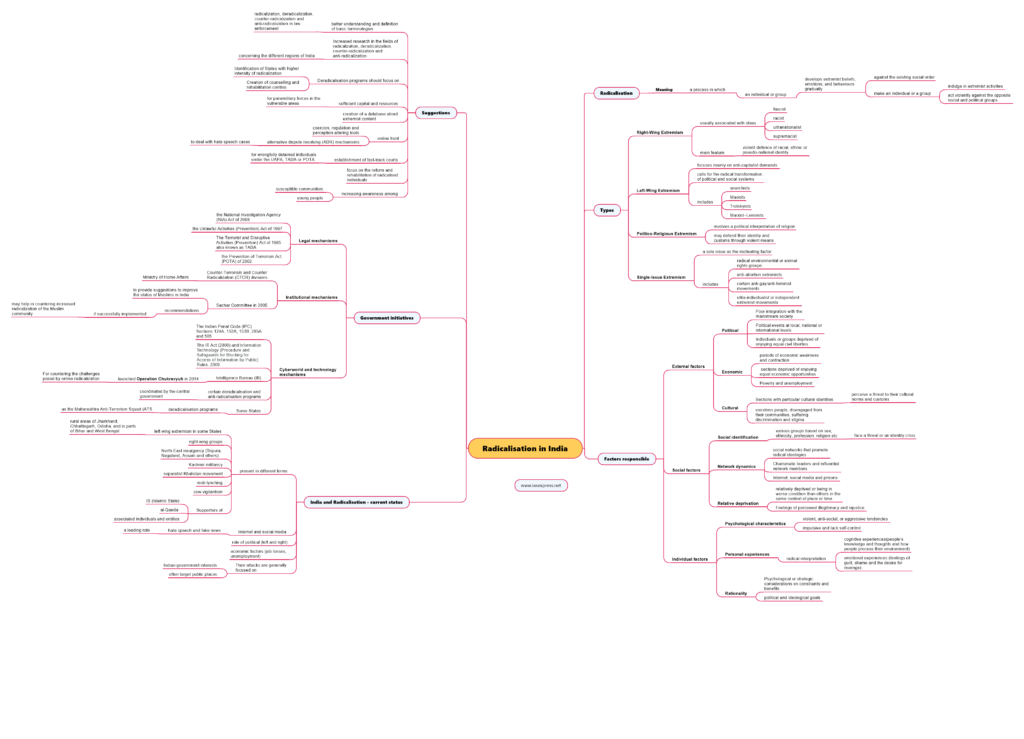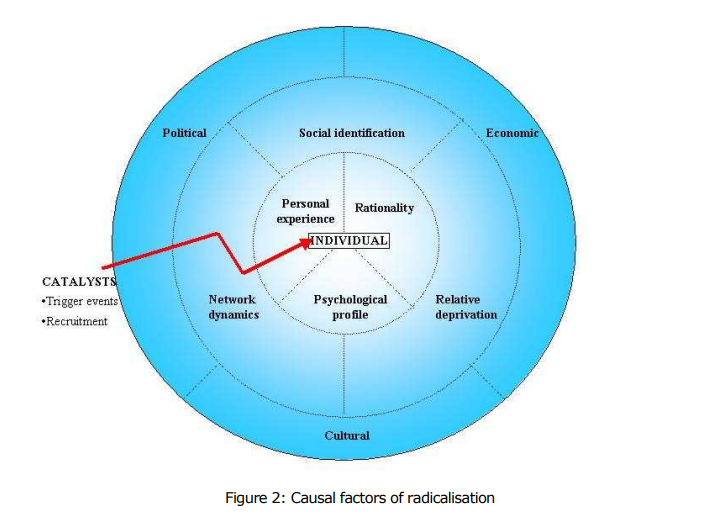Radicalisation in India – Types, Causes and Government Efforts

In a recently published book: – “The Kashmir Conundrum: The Quest for Peace in a Troubled Land”, former Army chief Gen (retd) N C Vij has stated that militancy in Kashmir may cease to exist in the coming eight to ten years. The statement comes as a hope since Kashmir has long been the ground of extreme radicalisation. However, radicalisation in India is not only confined to Kashmir but is present in most of the parts in different forms. Radical groups in various parts of the country with diverse motives tend to attack civilians and governmental assets to fulfil their radical ends. Thus, understanding radicalisation and bringing an end to it has become a policy focus for the government for a long time.

Radicalisation – Meaning
- It is a process in which an individual or group (social, economic or political etc.) develops extremist beliefs, emotions, and behaviours gradually through multiple pathways against the existing social order.
- It makes an individual or a group indulge in extremist activities and act violently against the opposite social and political groups.
- The process of radicalisation involves changes in attitudes, beliefs, behaviour, ideals, goals, ideology, and willingness to bring about radical changes in society which later become extreme.
- The extreme aspects may be political, social, religious, ideological, economic or societal.
- The term gained much attention after the 9/11 terrorist attacks in the US.
- It takes diverse forms depending on the context and time and may be associated with different causes or ideologies.
Radicalisation – Types
- Right-Wing Extremism
- This type of radicalisation is usually associated with fascist, racist, ultranationalist and supremacist ideas.
- Its main feature includes violent defence of racial, ethnic or pseudo-national identity.
- It is also associated with radical hostility towards state authorities, minorities, immigrants and/or left-wing political groups.
- Left-Wing Extremism
- It focuses mainly on anti-capitalist demands and calls for the radical transformation of political and social systems that they consider responsible for social inequalities.
- For furthering their cause, they may eventually end up adopting violent means.
- This category includes anarchists, Maoists, Trotskyists and Marxist–Leninists who use violence to advocate for their cause.
- Politico-Religious Extremism
- This form of radicalisation generally involves a political interpretation of religion and may defend their identity and customs through violent means that they perceive to be under attack.
- Any religion can have such radical motives.
- Single-Issue Extremism
- This type of radicalisation has a sole issue as the motivating factor.
- The category usually includes radical environmental or animal rights groups, anti-abortion extremists, certain anti-gay/anti-feminist movements, and ultra-individualist or independent extremist movements. Mass murderers who commit such crimes motivated by various ideologies wholly or partially may also fall under this category.
- They also adopt violent means to further their cause.
Factors responsible
- External factors
- Political
- Poor integration with the mainstream society or marginalization of a particular section from the political sphere also leads to extremist ideas and activities.
- Political events at local, national or international levels may also promote extremist tendencies.
- Individuals or groups deprived of enjoying equal civil liberties are particularly vulnerable to radical ideas.
- Economic
- Extremist activities are often related to periods of economic weakness and contraction.
- Similarly, those sections who find themselves marginally deprived of enjoying equal economic opportunities tend to follow extremism.
- Poverty and unemployment are leading economic factors that result in extremist ideas and act as a catalyst in furthering violent ideas.
- Cultural
- Sections with particular cultural identities who perceive a threat to their cultural norms and customs may become radical to protect their identity from changing due to external factors such as government policies etc.
- Groups of relatively voiceless people, disengaged from their communities, suffering discrimination and stigma who tend to be angry, and hopeless show more incidents of extremism (terrorism).
- Political
- Social factors
- Social identification
- Groups tend to identify themselves based on various groups such as sex, ethnicity, profession, religion etc. When such groups face a threat or an identity crisis, they may turn radical.
- Network dynamics
- People engaged in social networks that promote radical ideologies and attitudes are vulnerable to radicalism.
- Charismatic leaders and influential network members may exert a strong influence on general opinion formation and behaviour in networks.
- Internet, social media and prisons are perceived to be fertile grounds for the formation and spread of radical views.
- Relative deprivation
- When certain individuals or groups feel relatively deprived or being in worse condition than others in the same context of place or time, they may turn radical to demand equal treatment and an improvement in their condition.
- Feelings of perceived illegitimacy and injustice fuel feelings of anger to gain social, psychological or political significance leading to extremist actions.
- Social identification
- Individual factors
- Psychological characteristics
- These may include individuals having violent, anti-social, or aggressive tendencies who are often impulsive, depressed or anxious and might be seeking novelty and identification and lack self-control.
- The above-mentioned psychological factors and the tendency of such individuals of being vulnerable to the radical views of charismatic leaders turn them into extremists.
- Personal experiences
- These include cognitive (people’s knowledge and thoughts and how people process their environment), or emotional experiences (feelings of guilt, shame and the desire for revenge).
- The radical interpretation of such experiences may make individuals or groups susceptible to radical views or ideas.
- Rationality
- Psychological or strategic considerations on constraints and benefits may also attract individuals or groups to radicalism.
- Some turn to extremism consciously to give effect to political and ideological goals whereas others simply do it for action and adventure, or to seek group membership to obtain a positive identity.
- Psychological characteristics

Radicalisation and India – current status
- Radicalisation in India is present in different forms. These are left-wing extremism in some States (rural areas of Jharkhand, Chhattisgarh, Odisha, and in parts of Bihar and West Bengal), right-wing groups, North-East insurgency (Tripura, Nagaland, Assam and others), Kashmir militancy, the separatist Khalistan movement, mob lynching, cow vigilantism etc.
- Supporters of the IS (Islamic State) in States like Telangana, Kerala, Andhra Pradesh, Karnataka and Tamil Nadu, supporters of al-Qaeda and associated individuals and entities add more to the list.
- Internet and social media and various elements present on it such as hate speech and fake news are playing a leading role in spreading radical views in India.
- The role of political (left and right) and economic factors (job losses, unemployment) cannot be downplayed either.
- Their attacks are generally focused on Indian government interests and thus they often target public places such as restaurants, hotels, railway stations, markets, places of worship, festivals and sporting venues.
- However, the government has been taking these issues seriously and has taken several initiatives to curb radicalisation in India.
Government initiatives
- Legal mechanisms
- The National Investigation Agency (NIA) Act was introduced in 2008 after the terrorist attacks in Mumbai (2008).
- It is empowered to deal with terror-related activities across the country, without the special permission of States.
- It was amended in 2019 to add some new provisions.
- The Unlawful Activities (Prevention) Act (UAPA) was introduced in 1967.
- The aim was to “provide for the more effective prevention of certain unlawful activities of individuals and associations dealing with terrorist activities.”
- In 2019, the Act was amended to broaden its scope.
- Other Acts include the Terrorist and Disruptive Activities (Prevention) Act of 1985 also known as TADA and the Prevention of Terrorism Act (POTA) of 2002.
- The National Investigation Agency (NIA) Act was introduced in 2008 after the terrorist attacks in Mumbai (2008).
- Institutional mechanisms
- Counter-Terrorism and Counter Radicalization (CTCR) divisions of the Ministry of Home Affairs are the key wings of the Government of India dealing with “radicalization, counter-radicalization, terrorism and counter-terrorism”.
- The main function of this department is to interpret and implement two key Acts of the Government of India. These are the National Investigation Agency Act (NIA) of 2008 and the Unlawful Activities (Prevention) Act of 1967.
- The Government of India set up the Sachar Committee in 2005 to look into the social, economic and educational conditions of the Muslims in India, as well as to provide suggestions to improve their status.
- The Government of India on the recommendations of the Committee initiated several reforms related to education, skill development, access to credit, special development initiatives, measures for affirmative action, the development of waqf properties (donated for religious or charitable purposes), the Communal Violence (Prevention) Bill and sensitizing government employees, among other issues.
- The recommendations by the Committee if successfully implemented may help in countering increased radicalization of the Muslim community.
- Counter-Terrorism and Counter Radicalization (CTCR) divisions of the Ministry of Home Affairs are the key wings of the Government of India dealing with “radicalization, counter-radicalization, terrorism and counter-terrorism”.
- Cyberworld and technology mechanisms
- India has a large number of Internet users and this increases the risk of young minds being more susceptible to radical ideas. Therefore, to counter the increasing presence of extremist sentiments in the cyber domain, the Government has taken several steps. They include:
- The Indian Penal Code (IPC) Sections 124A, 153A, 153B, 295A and 505 that prescribe a firm approach against any word, spoken or written, that promotes disharmony, enmity, hatred or ill-will or offends or insults on basis of religion, culture, language, region, caste, community or race.
- The IT Act (2000) and Information Technology (Procedure and Safeguards for Blocking for Access of Information by Public) Rules, 2009 for security of the State, friendly relations with foreign States, public order or for preventing incitement to the commission of an offence.
- For countering the challenges posed by online radicalization, the Intelligence Bureau (IB) reportedly launched Operation Chukravyuh in late 2014.
- India has a large number of Internet users and this increases the risk of young minds being more susceptible to radical ideas. Therefore, to counter the increasing presence of extremist sentiments in the cyber domain, the Government has taken several steps. They include:
- There are also certain deradicalisation and anti-radicalisation programs that are coordinated by the central government such as Civic Action Programs implemented by the Seema Shastra Bal (SSB) along the Indo-Nepal and Indo-Bhutan Borders.
- Some States have also come with deradicalisation programs such as the Maharashtra Anti-Terrorism Squad (ATS). It has been quite successful in its attempts of deradicalising numerous individuals influenced by extremist ideas.
Suggestions
- A better understanding and definition of basic terminologies such as radicalization, deradicalization, counter-radicalization and anti-radicalization in law enforcement at all levels is necessary.
- Increased research in the fields of radicalization, deradicalization, counter-radicalization and anti-radicalization concerning the different regions of India may help in understanding the factors behind radicalisation.
- Deradicalisation programs should focus on:
- Identification of States with higher intensity of radicalization.
- Creation of counselling and rehabilitation centres with programs including psychologists, counsellors and religious leaders.
- Lack of funding often results in a significant lapse in coordination as well as regularity of the programs conducted by these security forces in vulnerable areas. Therefore, sufficient capital and resources for paramilitary forces in the vulnerable areas should be ensured.
- The creation of a database about extremist content may help in understanding the propaganda and ideologies of extremists. This may help in facilitating disengagement or creating counter-radicalization and/or counter-propaganda policies.
- On the online front, coercion, regulation and perception-altering tools may help. There should be alternative dispute resolving (ADR) mechanisms to deal with hate speech cases.
- There is a need for the establishment of fast-track courts for addressing the issues of wrongfully detained individuals under the UAPA, TADA or POTA.
- There should be a focus on the reform and rehabilitation of individuals who have been radicalised.
- Lastly, increasing awareness among the susceptible communities and young people against radicalisation may prove to be helpful.
Way forward
Radicalisation in India has always been a threat to the peace and security of the state. Extremist ideas of few individuals have proven to be devastating for fellow citizens. Although the government at various levels are taking considerable efforts to counter radicalisation yet the threat from radicalisation remains underestimated and understudied in India. Thus, a focus on philosophies, precursors and process nodes that drive extremist views and coordinated efforts by various stakeholders on de-radicalisation may help.
Practise Question
Q. Do you think that the existing legal frameworks in India are sufficient to deal with radicalisation? Comment.
- https://www.tribuneindia.com/news/comment/the-challenges-of-de-radicalisation-in-india-33238
- https://jgu.s3.ap-south-1.amazonaws.com/JSIA/POLICY+BRIEF+-+CSS+-+India’s+need+for+a+counter-radicalization+strategy.pdf
- https://www.tandfonline.com/doi/abs/10.1080/09546553.2015.1038523?journalCode=ftpv20
- http://www.gdr-elsj.eu/wp-content/uploads/2014/02/doc2-WP4-Del-7.pdf
- https://www.ojp.gov/pdffiles1/nij/249947.pdf
- https://www.parliament.nsw.gov.au/researchpapers/Documents/radicalisation-and-violent-extremism-causes-and-/Radicalisation%20eBrief.pdf
- https://info-radical.org/en/cprlv/news/
- https://www.sv.uio.no/c-rex/english/groups/compendium/what-is-radicalization.html
- https://www.greaterkashmir.com/kashmir/jk-may-be-militancy-free-in-8-10-yrs-ex-army-chief-vij-in-new-book
If you like this post, please share your feedback in the comments section below so that we will upload more posts like this.


Thanks for providing wonderful content